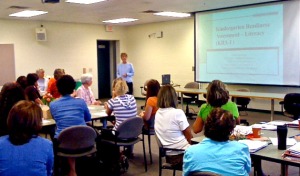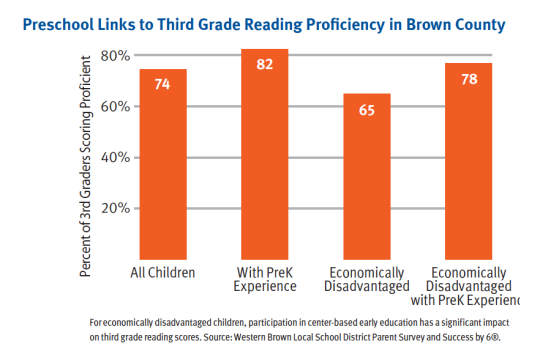 Research shows that in the first five years of a child’s life, the brain grows faster than any other time in their life. Therefore, the first five years of a child’s life are the most important for building a strong foundation for success in school and beyond. It is also shown that high-quality, positive learning experiences and supportive environments have a huge impact on a child’s readiness for school. So, why do we wait until age five before we begin developing relationships with families of young children? Why not develop partnerships with local agencies, caregivers and others who have the strongest influence on young children?
Research shows that in the first five years of a child’s life, the brain grows faster than any other time in their life. Therefore, the first five years of a child’s life are the most important for building a strong foundation for success in school and beyond. It is also shown that high-quality, positive learning experiences and supportive environments have a huge impact on a child’s readiness for school. So, why do we wait until age five before we begin developing relationships with families of young children? Why not develop partnerships with local agencies, caregivers and others who have the strongest influence on young children?
In southwest Ohio, four Race to the Top (RttT) districts have developed a partnership with United Way of Greater Cincinnati’s Success By 6® (SB6) initiative. SB6 focuses on improving school readiness through local community change by providing all students and children in the community with the needed support to prepare them for entering primary grades. It combines the knowledge and experience of many people in the community who work with young children to make sure the transition to school is smooth and successful for each student. SB6 believes a child’s foundation for learning is important to their future success and the ultimate outcome is that young children enter school ready to succeed.
Western Brown Local School in Brown County, Ohio began working with United Way of Greater Cincinnati in 2008 to develop a an active early childhood community supported by leaders of public and private agencies including the Corporation for Ohio Appalachian Development (COAD), the Hopewell Center, Adams Brown Head Start, the Brown County Educational Service Center and the Brown County Department of Job and Family Services. As of 2013, the partnership has turned into a countywide initiative that includes Eastern Brown, Fayetteville-Perry, Georgetown and Ripley Union Lewis Huntington.
The Brown County SB6 partnership has not only strengthened the efforts of providing high quality early education experiences to young children but has also created opportunities for all educators in both public and private agencies to network and help each other grow as teachers and caregivers.
Within the last five years, the group has celebrated many accomplishments while working through the challenges that naturally come with reform. One of the first actions by the group was to explore and decide what were the most important goals to be addressed. The partnership decided their focus areas would be to create professional networking and collaborative learning opportunities, implement common PreK formative assessments, increase state licensed centers and ‘STAR’ rated centers, and increase Kindergarten Readiness Assessment – Literacy (KRA-L) scores in the top two bands.
Professional Networks and Development
The partnership host two Success By 6® Together (SB6 Together) events in which all family care providers, kindergarten, Head Start, County PreK and Childcare teachers are invited to analyze KRA-L results, attend training on new assessments, academic and behavior interventions, or training on issues that effect all stakeholders such as the Third Grade Reading Guarantee or Ohio’s new kindergarten readiness assessment. The SB6 Together events have been beneficial to participants, as well as showing a significant effect on Western Brown’s KRA-L scores. For example, in 2007-2008, the average KRA-L score for the district was 16.9. In 2011-2012 the KRA-L average for the district increased to 19.00. In addition, the percentage of students scoring in the lowest band was 37.5 percent in 2007-2008 but decreased to 23.9 percent in 2011-2012. The SB6 partnership has also developed a network of family home care providers in the county that meet regularly to discuss issues and concerns they face each day and attend training to help in plan academic activities. The network has grown from providers in 2011 to 15 in 2013.
Common Assessments
Get It Got Go (GGG) was the partnership’s first common assessment administered to all Head Start classrooms, PreK classrooms and childcare centers. Teachers attended training on the administration and purpose of the assessment, as well as how to use results to help guide instruction and interventions. Rhyming and alliteration are the two main concepts assessed by GGG and the first two topics for the SB6 Together events. One rewarding moment in the partnership occurred when several local childcare center teachers learned their students scored higher in the rhyming and alliteration areas on the KRA-L than in previous years. The power of monitoring student growth fueled the partnership’s energy and purpose, and today our teachers know that together they can make the changes needed to make a difference.
Within the last two years, the partnership has transitioned to the Bracken, a more comprehensive assessment that provides teachers detailed information on each student’s needs and growth. The correlation of the Bracken and the new kindergarten readiness assessment will be a concern for the partnership in the upcoming years.
High Quality Centers

It was very apparent Brown County had a very limited number of registered childcare centers and it was imperative to work with, encourage and support these centers to become STAR rated. The goal was to have 60 percent of local childcare centers STAR rated by 2013. Currently, Brown County has met their goal with some centers reaching a 2-STAR rating. They also reached out to family childcare providers to provide support and training to become registered providers.
Student Growth
Close attention has been given to monitoring the correlation between KRA-L data and student sub-groups like low-income families and children with PreK experiences. These studies indicate the importance of quality PreK centers and environments for low-income families. In 2008, Western Brown started giving all incoming kindergarten parents a survey of their child’s learning history, allowing districts in the partnership the ability to link KRA-L results to PreK experiences. The annual Pre-K Experience Survey Report, compiled by Innovations in Community Research and Evaluation at Cincinnati Children’s Hospital, gives crucial evidence of the partnership’s work and guides kindergarten teachers across the county to better meet our students needs. This year’s county summary report indicated the following:
a) 73.4 percent of children reporting early childhood experiences between the ages of 3 and 5 indicated participation in a center-based program education experience outside the home.
b) 40.9 percent of children who participated in a formal center-based program education experience between 3 and 5 years of age tested in Band 2; an additional 36.2 percent tested in Band 3.
c) The average KRA-L score of children who had participated in a center-based program education experience between 3 and 5 years of age was 19.4; the average score of those children 3 to 5 who had not participated in a center-based program education experience was 17.2.
d) Center-based programs continue to be important to KRA-L performance for children from low-income families. Economically disadvantaged children, who also reported center-based program experience, had a mean KRA-L score of 18.5, while those who did not have center-based program had a mean KRA-L score of 15.8. The difference of 2.7 points between these groups is statistically significant below p=.01.
You may access the full Brown County Summary Report 2012-2013 here.
Recently, the SB6 partnership linked research from the 2008 PreK surveys and KRA-L results, to the 2012 third grade Ohio Achievement Assessments. Success By 6 reports on the status of child well-being and early childhood education in Successful Starts Third Edition. Again, the importance of quality pre-school experiences is linked to success in school by all subgroups.
The SB6 Partnership in Brown County meets monthly and its members are not only collaborative and focused on achieving the partnership’s goals but also have become educational colleagues who look to each other for support and guidance in all aspects of their roles as administrators, supervisors, and teachers. When asked what they felt about SB6, one teacher responded, “When we get together and share our successes and challenges, there’s a huge potential for growth. Not only for us as professionals but for our students too. Reaching out and developing a relationship with teachers and families of PreK students is something we should have done a long time ago and I’m thrilled we are beginning to break down the walls that have forever kept us apart.”
The world today has forced us to step outside the four walls of our classrooms and its time to break the K-12 barrier that has limited us from developing the partnership needed to help children be better prepared for entering those school doors each year.
